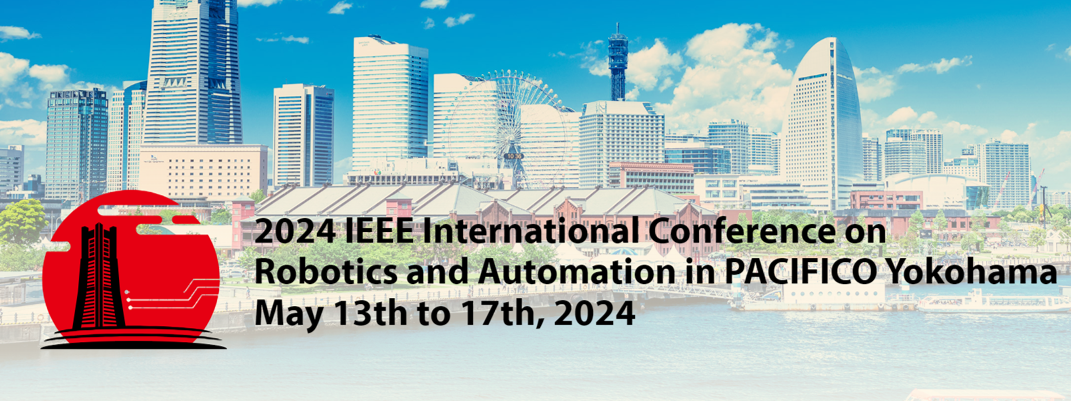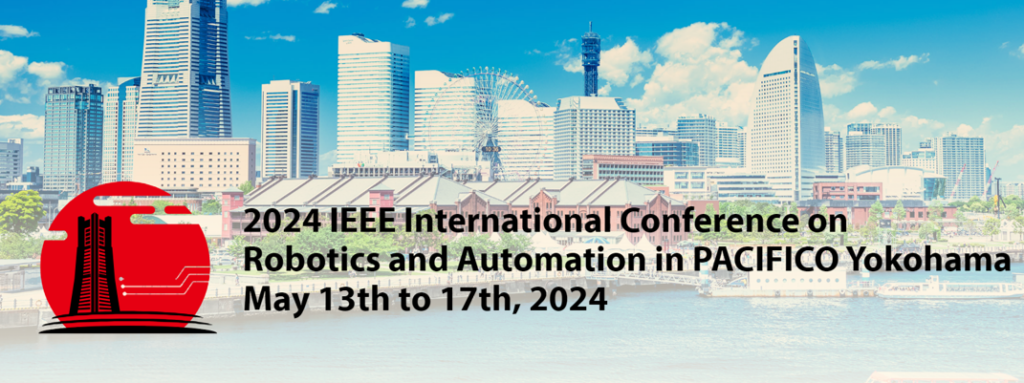
The IEEE International Conference on Robotics and Automation (ICRA) 2024 will be held from May 13 to 17 in Yokohama, Japan. The event will include plenary and keynote lectures, technical sessions, posters, workshops and tutorials.
Speakers in plenary
This year there are three plenary sessions at the conference:
- Yoki Matsuoka – How to turn a roboticist into a corporate explorer
- Sami Haddadin – The Grand Robotics Accelerator: collective learning of optimal embodied artificial intelligence
- Sunil K Agrawal – Rehabilitation robotics: How to improve daily functions in people with disabilities?
Main lectures
There will be 15 keynote lectures by:
- Lianqing Liu – Biosyncretic sensing, control and intelligence for robotics
- Dawn M. Tilbury – Digital twins for production automation
- Claudio Pacchierotti – Beyond Force Feedback: Skin Haptics in Human-Centered Robotics
- Yu Sun – Medical Robotics for Cellular Surgery – Science and Applications
- Yasuhisa Hirata – Adaptable robots with artificial intelligence to create a living society – Moonshot R&D projects in Japan
- Calin Belta – Formal methods for safety-critical inspection
- Manuel Catalano – Robots in the wild: From research labs to the real world
- Harold Soh – Building guidance bridges with generative models for robot learning and control
- Lorenzo Sabattini – Unleashing the power of many: decentralized control of multi-robot systems
- Myunghee Kim – Co-adaptation of a human-wearable robot
- Yoko Yamanishi – Emerging functions of electrically induced bubbles and intracellular cybernetic avatar
- Kensuke Harada – Robotic manipulation focused on industrial applications
- Iolanda Leite – The Quest for Social Robot Autonomy
- Rong Xiong – Integrating Robotics and Artificial Intelligence: Changes and Challenges
- Mariana Medina-Sanchez – Tiny Robots, Big Impact: Transforming Gynecological Care
Tutorials
The courses will be held on Monday, May 13 and Friday, May 17.
- Ergodic Control course
- A Connected Robotics platform for deploying ROS in real-world network settings
- How to manage bot fleets with open source software
- Riemann and Gauss Meet Asimov: 2nd Tutorial on Geometric Methods for Learning, Optimizing and Controlling Robots
- Cloud and Fog Robotics: Hands-on learning with ROS2 and FogROS2
- Choreographic Swarms: From Scripting to Emergent Expressive Behavior to CONNECTING Humans and Robots
Workshops
Workshops will also be held on Monday 13 May and Friday 17 May. There are 73 to choose from this year.
- Debates on the future of robotics research
- Field Robotics Workshop
- Continuum and soft robotics for medical applications with rising stars on stage
- Agile robotics: From perception to dynamic action
- 6th workshop on long-term prediction of human movement
- 2nd HERMES workshop: Sensing and perception of multiple robots in extreme environments
- Towards collaborative partners: Design, shared control and learning of robots for physical human-robot interaction
- Society of avatar symbiosis through experiments in the social field
- 3rd workshop on the future of construction: Lifelong learning of robots on changing construction sites
- What Does Responsible Robotics Mean?: Expanding the Horizons of Roboticists from Academic, Government, and Philosophical Perspectives
- Workshop on Ontologies and Standards for Robotics and Automation
- Exploring role allocation in human-robot co-manipulation
- C4SR+: Continuum, Compliant, Cooperative, Cognitive Surgical Robotic Systems in the Embodied AI Era
- Dynamic Duos: Matching the Human-Robot Collaborator in Manufacturing
- Autonomy in robotic surgery: State-of-the-art technical and regulatory challenges for clinical applications
- 2. ICRA-RAMI Robotic Assisted Medical Imaging
- Back to the Future: Robot Learning Going Probabilistic
- Bioinspired, soft, and other new design paradigms for aerospace robotics
- Impulsive motion in soft robotic and microrobotic systems
- Agile Movements II: Animal Behavior, Biomechanics and Robotic Devices
- Bimanual Manipulation: For Kitchen Challenges
- Robotics, psychology and neuroscience of body augmentation
- Sustainable soft robots: Working with the environment
- Robotics and sustainability: a two-way relationship
- 2nd Workshop on Mobile Manipulation and Embodied Intelligence (MOMA) Integrating Perception, Learning and Control for Full Autonomy
- (Re)designing the tree of robotic life: a game of alternate timelines
- Advancing Sustainable Food Systems through Agrorobotic Innovation
- Co-design in robotics: theory, practice and challenges
- Robot Trust for Symbiotic Society
- Soft continuum manipulators: Bottlenecks and applications
- Advanced Human-Robot Interfaces Based on Physiological Signals and Sensory Stimulations
- Assistance systems: Laboratory for patient care
- MAD-Games: Workshop on Dynamic Multi-Agent Games
- Workshop on Robot Ethics – Ethical, Legal and User Perspectives in Robotics and Automation (WOROBET)
- Applications and future directions of affective technologies
- ProxyTouch: Whole-Body Proxy-Tactile Architectures for Industrial and Service Applications
- Biologically inspired robotics and robotics for biology
- A Future Plan for Learning Sensorimotor Skills for Robot Manipulation
- Robotics and automation in the nuclear environment
- 3D visual representation for robot manipulation
- Advances in Trajectory Optimization and Predictive Model Control for Leg Systems – 2nd Edition
- Robots for understanding natural ecosystems
- Cooking Robotics: Perception and Motion Planning
- Robot Software Architectures (RSA24)
- Multi-object grasping: Progress and prospects
- First Workshop on Visual Language Models for Navigation and Manipulation
- Radar in Robotics: From Signal Resilience to Navigation
- Anthropomorphic and Zoomorphic End-Effectors: Benefit or Unnecessary Bias?
- Workshop on durable off-road autonomy
- Breaking Swarm Stereotypes
- Translational research in medical robotics: From the laboratory to clinical use – how?
- 4. Workshop on representation and manipulation of deformable objects
- Locomotive Handling: Algorithms, Challenges, and Applications
- Cognition across species: from nature to robotic applications
- Unconventional Robots: Universal Lessons for Designing Unique Systems
- Accelerating discovery in science labs with AI and robotics
- Human and robot accompaniment for health care and wellness: Which form of accompaniment for which type of care?
- Humanoid Whole Body Control: From Understanding Human Movement to Humanoid Locomotion
- RoboNerF: Neural Fields in Robotics
- ViTac 2024: Robot execution through visual-tactile perception
- Supervised autonomy: how to shape human-robot interaction from the body to the brain
- Robots and roboticists in the age of climate change
- Multilateral human-centered teleoperation: Perception, telecommunications, and coordination
- Innovation and application of human modeling in human-robot physical interaction
- How to ensure the correct behavior of the robot? Software challenges in formal methods for robotics
- Advancing wearables and applications through new design, sensing, control and artificial intelligence
- Wearable intelligence for healthcare robotics (WIHR): from brain activity to body movements
- New technologies in intelligent exoskeleton systems
- Pushing the boundaries of Sim2Real: Robotics, biomechanics, plasma physics, chip design and more
- Nursing robotics: a new field emerging from the integration of robotics and nursing science
- Speed dating to long-term relationships: The Art-robot Residence Enabled by Common Language
- Workshop on Human-aligned Reinforcement Learning for autonomous agents and robots
- 2nd Workshop on NeuroDesign in Human-Robot Interaction: Creating Engaging HRI Technology Your Brain Can’t Resist
You can see an overview of the program here, a detailed program is available here.
